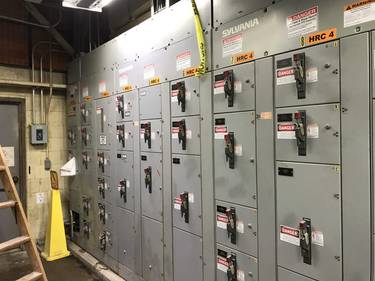Ingredients Manufacturer Discovers Alternate MCC Solution
Solving Real Problems in the Connected Power Lab
EECO’s Connected Power Lab in Raleigh, N.C. and Columbia S.C., is a learning environment to explore interoperability of smart devices over EtherNet/IP. It’s a space to virtually experience innovative technologies and their functional application on the plant floor.
Ingredients Manufacturer – North Carolina
A North Carolina manufacturer of sweeteners and other ingredients was aware for several years that its Motor Control Centers (MCCs) needed to be replaced. The plant is 36 years old. They wanted more options.

Their existing 13-section Sylvania MCC was approaching its end of life cycle. The maintenance team was scavenging parts from another, similar MCC to repair the low-voltage MCC located in its mill. Replacement parts are very limited on the Sylvania model. The manufacturer also suffered a recent arc flash event on the existing MCC. They needed a plan for a new MCC; one that would easily integrate with an AB Logix platform and specifically an EtherNet/IP network.
The older MCC required that the buckets “yanked and slammed” in and out manually without being able to isolate the system prior. In addition, the basic system didn’t have any communications capabilities to monitor the running systems. And, with the previous arc flash incident, safety was a factor in selecting the proper MCC.
What Led to the Need for a New Motor Control Center?
- Excessive failures.
- The door gaskets and latching mechanisms were not working very well. The disconnect-switch operator experienced second-degree burns during an arc flash incident with the door closed.
- The existing MCC design was long past prime.
- Current operators are trained to change fuses. The new MCC has breakers that eliminate the need for operators to change fuses.
- Trouble locating parts since Sylvania went out of business close to the time the MCC was purchased in 1981.
The company needed to decide on a replacement MCC before a planned outage. Timeliness was a factor. The mill uses EtherNet/IP communications and other AB MCCs are intelligent, but they were never fully configured to take advantage of capabilities.
Company Goals for the New MCC
- Prevent unnecessary costs associated with equipment downtime
- Spares availability
- Easy field maintenance
- Arc flash safety
The manufacturer was provided the opportunity to demo an alternate solution at EECO’s Connected Power Lab.
The intent of the lab experience is to virtually experience innovative technologies and their functional application on the plant floor.
Connected Power Lab Goals for the Manufacturer
- Timely delivery of replacement MCC in support of the timeline for an upcoming planned outage
- Easy integration with Control Logix/EtherNet IP platform
- Configuration of communications and smart devices must allow for technician replacement of smart components without the need for readdressing IP settings
- Reduce risk to personnel and equipment associated with arc flash events
It was important to demonstrate the power and flexibility of open architecture to the manufacturer. The model recommended was the Eaton FlashGard MCC — the second-tier model. To compare, the first-tier is the “basic” MCC; tier two is the arc-prevention MCC; and the third tier model is the same as the second, but is made of 12-gauge sheet metal instead of 14-gauge to contain any arc blast energy, if and when an incident might occur. EECO’s instructional guides will help the engineers integrate and commission the product on their own, in addition to some additional support from EECO/Eaton when necessary.
After demoing how easily the Eaton FlashGard MCC integrates with the company’s ControlLogix PLC, the manufacturer decided the alternate solution was the best fit for its overall modernization plan. They saw value in upgrading to a system that was designed for reliability, arc-flash safety and easily field serviceable.
What are (will be) the advantages and/or impact of the new MCC?
- More reliable equipment
- More data collected on running equipment (motor amp trending / alarming)
- Easier to wire due to networking
In addition, with the FlashGard series MCC, the individual buckets can be fully isolated from the Bus with the racking mechanism before the buckets are physically able to be removed. With the FlashGard and added smart capabilities, each bucket can be controlled through the ControlLogix processor and provide real-time data and monitoring parameters; thus providing access to any issues prior to a potential failure.










